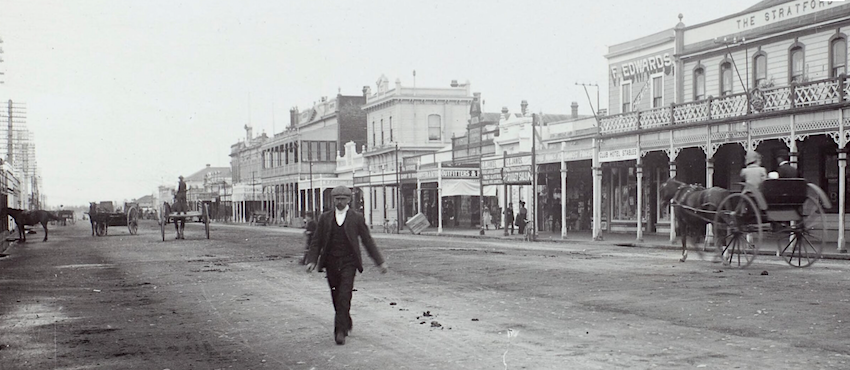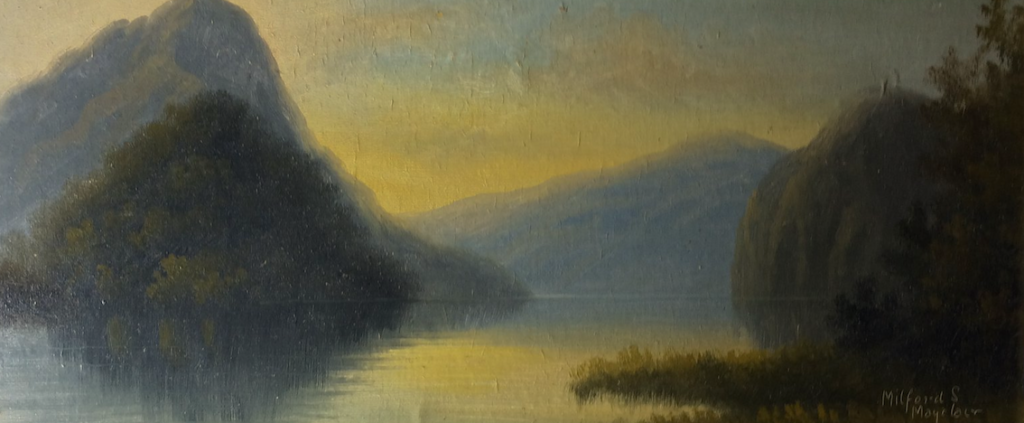
Joseph Richard Mayclair (1881-1956)

“Mayclair” is another name that has been suggested as a pseudonym for Henry Thomas Garratt. Garratt had a penchant for using exotic and artistic sounding , if not fictitious aliases like “de Ritz,” which in the colonial period at least, would have been associated with a glamorous, high class Parisian Hotel or a famous thoroughbred yearling. “Mayclair” has a similar romantic quality and certainly it is a very rare surname in New Zealand and internationally, then and now, so perhaps the assumption that the landscape paintings signed “Mayclair” belong to Garratt is a reasonable one. Especially as up until now, hardly anything was known about the artist behind the name.
The records, meagre as they are, reveal that there was actually a “Mayclair” family in New Zealand at the turn of the 19th century, two of whom were landscape painters. Both were called Joseph Richard Mayclair, father and son, senior and junior (and just to complicate matters, there was a second son, Karl, who was a sign writer and also an artist, but not relevant to this story). The best source of information for both artists is on their headstones. Joseph senior was born in 1881, married a Mabel Clara Billows and died on the Coromandel Peninsula in 1956. They had four children; Joseph Richard, Roy, Timothy and Karl William and at the time of their deaths both mother and father were described as “important and valued New Zealand artists”. Their eldest son Joseph junior’s headstone, at Kamo Cemetery, just outside Whangarei, reads Joseph Richard Mayclair “Artist”, born 1906, died 1947. The few “Mayclair” paintings that we see today are mostly landscapes of Northland, Auckland and Coromandel scenes, and there are indeed two distinct signatures on their paintings “Mayclair” ‘snr’ or ‘jnr.’ Yet there are remarkably few Mayclairs in the records, birth, deaths and marriages, why would that be? It could be they were, as a family, rather slack at registering important life events or perhaps “Mayclair” was not their given name?
A little research into family history databases online reveals that Joseph Richard senior was the son of one Joseph Richard Leadbeater, an English settler who arrived in New Zealand from England before 1881 when our Joseph senior, the artist, was born in Wellington. At some point in his life Joseph senior changed his name to Mayclair. And it is this surname he passed on to his descendants, including his four sons and consequent grandchildren. Tracing the family of Joseph Richard Leadbeater senior, does indeed produce the same inter-generational use of first names, four sons with the same name as on the Mayclair graves, same spouse names and matching birth and death details. I think we can safely say, the artists we know as “Mayclair” where in fact born “Leadbeater.”
As an artist you may choose to use an alias for any number of reasons, including protecting your privacy, or to reinvent yourself or simply because it provides an exotic persona for someone with a boring name. Henry Thomas Garratt’s use of a number of aliases allowed him to create an absolute separation between his personal/business life and his life as a professional artist. That is, he continued to be a “Garratt” and for the most part, we assume, very few knew he was also “George de Ritz” and “Paul Wren.” The Mayclairs, on the other hand, adopted their new name wholesale, possibly because they thought “Leadbeater” was not quite the right name for aspiring artists in colonial New Zealand. On the other hand the various members of the Mayclair family in this period moved around the North Island a lot; Wellington, Fielding, New Plymouth, Wanganui, Whangarei, Auckland, New Plymouth and Palmerston North, as the subject matter of their surviving paintings attests. Generally the events of people lives in the colonial period are registered in the archives: family births, marriages and deaths notices in the newspapers, probates, army records and business dealings in national archives etc and in the case of artists, paintings in exhibitions or sales in auction houses. There are hardly any records of this sort for the Mayclair family. Perhaps another advantage of a new name is that it allows you to remain anonymous and relatively untraceable.
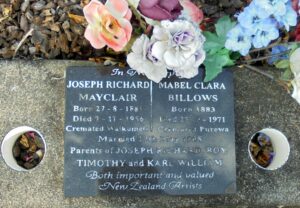
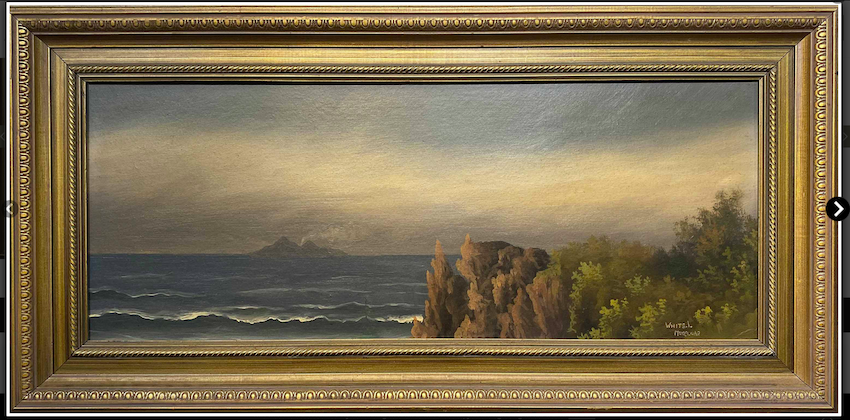
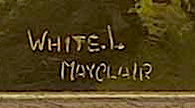
Joseph Richard Mayclair Junior (1906-1947)

Consequently, it is almost impossible to learn anything about Joseph senior, but a lot more about Joseph junior, largely because of his unconventional lifestyle and his unfortunate death. In mid-December 1947, the Northern Advocate reported the death of a Whangarei artist crushed between his 22ft launch and a barge as he was setting off from the town harbour for McLeod’s Bay. “While attempting to fend the launch off from a harbour barge, he slipped and fell, being crushed between the launch, which had its motor running, and a barge on which dredge pipes were assembled.” According to an eyewitness, the artist managed to get himself back on board his boat and switch the engine off, but then remained, slumped and unmoving on the deck as the boat drifted off to the other side of the bay. He died some time later from severe internal injuries, including crushed ribs and a punctured lung. The victim of this unfortunate accident was one Joseph Richard Mayclair, who the paper reported, was well known for his paintings of Northland coastal scenes. “The late Mr Mayclair was educated at Wanganui, and the family moved from place to place in New Zealand, painting such scenes as offered…. his father and mother, both of whom were artists, lived in the Stratford district for some years. Some of their work is widely known.”
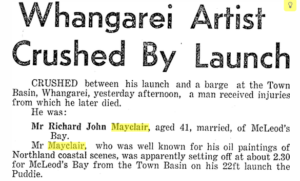
Before his untimely death, Joseph junior along with his wife spent most of their time traveling the country on foot, painting as they went, with the sole aim “of accomplishing their philosophy of life.” Interviewed by a reporter for the local paper in Stratford in 1941, the artist said they had travelled thus far over 400 miles on foot pulling all their belongings behind them in their hand-drawn caravan. He told the reporter “our wish is to live our own simple life in the way we want to…money has no interest to us. I suppose I could commercialize the idea, but I don’t want to. We are simple people and we dislike our privacy invaded. My wife and I want only enough to live a simple life that allows us to go on painting”
We also learn from these descriptions of his roving life and accidental death that Mayclair junior’s wife Vera was an artist as well, so too was Joseph senior’s wife Mabel and if we include Karl, the second son, who also claimed to be an artist we have a family of 5 “Mayclair” artists practicing landscape painting over a 50-year period. Joseph Richard Mayclair junior, perhaps no less than his father, was the quintessential itinerant artist. His account of his and his wife’s wandering and painting life, roaming the countryside at leisure, stopping to paint any picturesque view that caught their eye suggests a romantic and carefree lifestyle. It also suggests a lot of artistic activity, yet there are very few paintings attributable to them or the other artists in the family.

It is a real shame that next to nothing is known about this fascinating family of artists. What little is known is intriguing and raises so many questions about the way they lived their lives in early 20th century New Zealand, including questions more pertinent to this inquiry: did they have any art training, how many landscapes did they produce, how did they sell them and to whom? What we do know now is the artists Joseph Richard Mayclair, senior and junior, can be included in their own right, in the growing list of New Zealand’s early landscape painters.


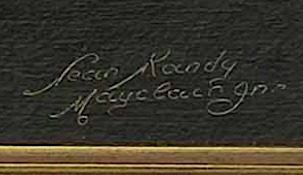
May 2021 – I have spent a bit of time tracing the movements of Joseph Richard Leadbeater after the family left Wellington – not yet using the name Mayclair – around the time of his marriage in 1905. Joseph Richard Junior was born as a Leadbeater in Fielding is 1907. Then the family appears for a brief time in Wanganui (1909), Pahiatua (1911) where Joseph Sen. gives his occupation as “sight specialist”, in 1914 they are living in Carterton and Joseph is now making his living as an artist. They are back in Wanganui in 1919 and by 1920 the Leadbeater family, now calling themselves Mayclair are in Stratford in Taranaki, where for a brief time Mayclair Sen., has a business called the Mayclair Art Depot., which is advertised regularly in the Stratford Evening Post over a two year period.
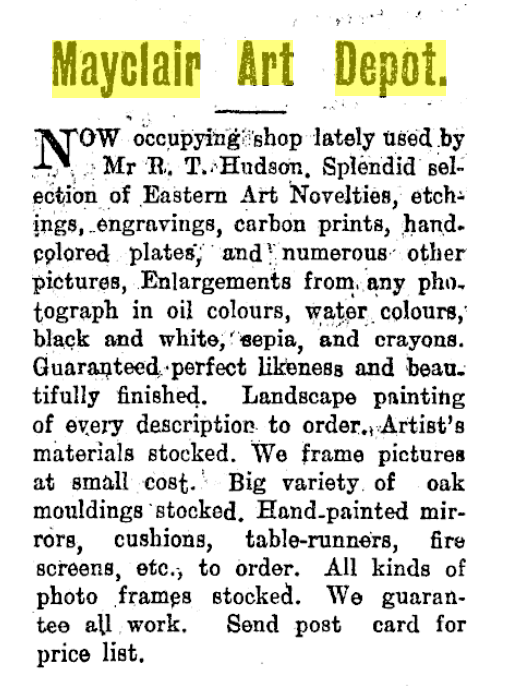
By the 1930s the whole family have given up using Leadbeater and are exclusively calling themselves “Mayclair”. They disappear from the record for well over a decade, and then reappear in the Whangarei area, åMayclair Sen. settled in Taurikura, and Mayclair Jnr at McLeod Bay, when he wasn’t travelling around the country on painting expeditions.
